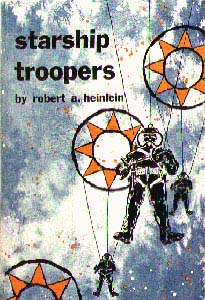
Serialised in the Magazine of Fantasy and Science-Fiction (Oct-Nov 1959) under the name "Starship Soldier".

Starship Troopers is a juvenile military science fiction novel by Robert A. Heinlein, first published (in abridged form) as a serial in The Magazine of Fantasy & Science Fiction (October, November 1959, as "Starship Soldier") and published hardcover in December, 1959.
The first-person narrative is about a young soldier named Juan "Johnnie" Rico and his exploits in the Mobile Infantry, a futuristic military unit equipped with powered armor
In addition to Heinlein's political views, Starship Troopers popularized a number of military concepts and innovations, some of which have inspired real life research. The novel's most noted innovation is the powered armor exoskeletons used by the Mobile Infantry.[24] These suits were controlled by the wearer's own movements, but powerfully augmented a soldier's strength, speed, weight carrying capacity (which allowed much heavier personal armament), jumping ability (including jet and rocket boost assistance), and provided the wearer with improved senses (infrared vision and night vision, radar, and amplified hearing), a completely self-contained personal environment including a drug-dispensing apparatus, sophisticated communications equipment, and tactical map displays. Their powered armor made the Mobile Infantry a hybrid between an infantry unit and an armored one.
Natural exoskeletons abound, encasing critters ranging from crickets to crabs. In more human contexts, robotic exoskeletons are most familiar from science fiction and comic books. In Robert A. Heinlein's 1959 novel Starship Troopers (G.P. Putnam's Sons), swift, merciless warriors in powered suits wreak havoc on their enemies with missiles and hydrogen bombs. To Heinlein, "the beauty of a powered suit [is that] you don't have to think about it. You don't have to drive it, fly it, conn it, operate it: you just wear it and it takes orders directly from your muscles . . . ."
Four years after Heinlein's book came out, Marvel Comics introduced the character Iron Man, a rich industrialist encased in a homemade iron exoskeleton that enables him to lift tons at a time, fire repulser rays, and even fly.
————
Heinlein possibly borrowed and expanded on the idea of self-powered space armor from E.E. "Doc" Smith's novels of the late 1930's. Possibly the specific idea of controlling it with negative feedback from the wearer's own movements is Heinlein's. [To be confirmed – RH cyberneticzoo.com 2011]
——————
E. E. Smith's Lensman series, (published from 1937 onwards), contains the earliest conceptualization of personal armour with both defensive and offensive capabilities for all environments. [To be confirmed – RH cyberneticzoo.com 2011]
——————-
Creakyfoot is a robot suit in a 1953 story called "Champion Robot" by E.R. James. Thanks David Buckley for indentifying this robot.
—————
Standard issue battle armor in Joe Haldeman's book The Forever War (1974) is an exoskeleton using logarithmic force amplification.
Powered armor operated remotely by telepresence also feature in Haldeman's Forever Peace (which shares themes with the previous The Forever War but is not a sequel in terms of setting and characters).